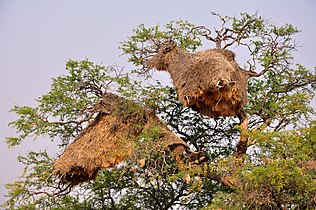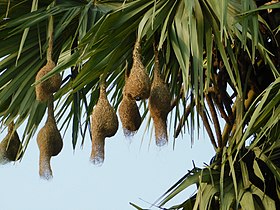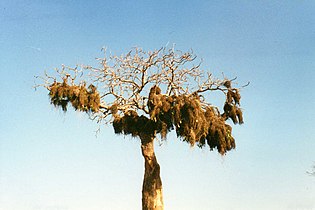Ploceidae
| Weavers | |
|---|---|

| |
| A male village weaver (Ploceus cucullatus bohndorffi), building his nest | |
| Scientific classification | |
| Domain: | Eukaryota |
| Kingdom: | Animalia |
| Phylum: | Chordata |
| Class: | Aves |
| Order: | Passeriformes |
| Superfamily: | Passeroidea |
| Family: | Ploceidae Sundevall, 1836 |
| Genera | |
|
See text. | |
Ploceidae is a family of small
Taxonomy and systematics
The family Ploceidae was introduced (as Ploceïdes) by Swedish zoologist
A 2017
| Ploceidae |
| |||||||||||||||||||||||||||||||||||||||||||||
Genera
The family includes 15 genera with a total of 122 species.
| Image | Genus | Species |
|---|---|---|

|
Bubalornis A. Smith, 1836 |
|

|
Dinemellia Reichenbach, 1863 |
|

|
Plocepasser A. Smith, 1836
|
|
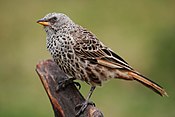
|
Histurgops Reichenow, 1887 |
|

|
Pseudonigrita Reichenow, 1903 |
|
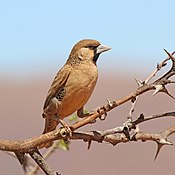
|
Philetairus A. Smith, 1837 |
|

|
Sporopipes Cabanis, 1847 |
|

|
Amblyospiza Sundevall, 1850 |
|
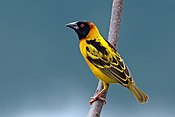
|
Ploceus Cuvier, 1816 |
|
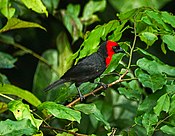
|
Malimbus Vieillot, 1805 |
|

|
Quelea Reichenbach, 1850 |
|
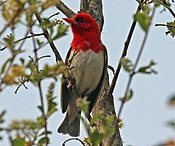
|
Anaplectes Reichenbach, 1863 |
|

|
Foudia Reichenbach, 1850
|
|
| Brachycope Reichenow, 1900 |
| |

|
Euplectes Swainson, 1829 |
|
Description
The males of many species in this family are brightly coloured, usually in red or yellow and black. Some species show variation in colour only in the breeding season. These are seed-eating birds with rounded conical bills.
Distribution and habitat
The weaverbird colonies may be found close to bodies of water.
Behaviour and ecology
Weavers are named for their elaborately woven nests. The nests vary in size, shape, material used, and construction techniques from species to species. Materials used for building nests include fine leaf fibers, grass, and twigs. Many species weave very fine nests using thin strands of leaf fiber, though some, like the buffalo-weavers, form massive untidy stick nests in their colonies, which may have spherical woven nests within. The
Many weaver species are gregarious and breed colonially.[2] The birds build their nests together for protection, often several to a branch. Usually the male birds weave the nests and use them as a form of display to lure prospective females.
Relationship to humans
They sometimes cause crop damage, notably the red-billed quelea, reputed to be the world's most numerous bird.[11][12]
Gallery
-
A nest in the early stages of construction
-
Weaverbirds at West Bengal
-
AdultSporopipesat its spherical grass nest, placed in a shrub
-
Plocepasser nest in Namibia, for year-round occupation.[10]
-
CommunalPhiletairusnests in central Namibia
-
Pseudonigritanest in Kenya, with entrance below
-
Black-breasted weaver nest suspended from grass, India
-
A baya weaver on his unfinished nest, northern India
-
Nests of a baya weaver colony suspended from a palm tree, India
-
MaleQuelea at nest concealed in thorny Senegaliashrub
-
Red bishop constructing a nest in reeds, South Africa
-
Nests of a colony of Sakalava weavers, Madagascar
-
Spherical village weaver nests suspended from a palm tree, West Africa
-
A southern masked weaver building his nest, Namibia
-
Hanging nest,Hargeysa, Somaliland, July 2019.
References
- S2CID 205841906.
- ^ ISBN 978-84-96553-68-2.
- hdl:2246/830.
- ^ Sundevall, Carl Jakob (1836). "Ornithologiskt system". Kongliga Svenska Vetenskapsakademiens Handlingar. 23: 43–130 [74].
- .
- PMID 30936315.
- S2CID 205841906.
- ^ .
- ^ Gill, Frank; Donsker, David; Rasmussen, Pamela, eds. (December 2023). "Old World sparrows, snowfinches, weavers". IOC World Bird List Version 14.1. International Ornithologists' Union. Retrieved 9 February 2024.
- ^ .
- ^ Fry, C.H. & Keith, S. (2004) The birds of Africa vol. VII. Christopher Helm, London
- . Retrieved 12 November 2021.
Further reading
- De Silva, T.N.; Peterson, A.T.; Perktas, U. (2019). "An extensive molecular phylogeny of weaverbirds (Aves: Ploceidae) unveils broad nonmonophyly of traditional genera and new relationships". The Auk. 20 (3): 1–21. .




![Plocepasser nest in Namibia, for year-round occupation.[10]](http://upload.wikimedia.org/wikipedia/commons/thumb/2/29/Nids_de_Plocepasser_mahali_%28Namibie%29_%283%29.jpg/315px-Nids_de_Plocepasser_mahali_%28Namibie%29_%283%29.jpg)
